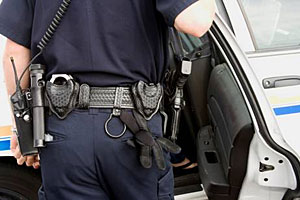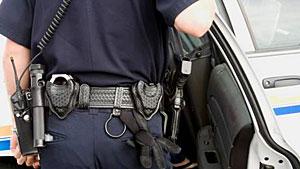Ergonomics and police duty belts: easing their load
Duty belt discomfort is a common complaint and a significant health and safety issue for uniformed police personnel. Pain in the low back, hip and pelvis can be caused by pressure exerted by the edges of the duty belt, holster shank and other equipment attached to the belt. Further compounding the problem is the length of time officers are required to perform their job behind the wheel of the patrol car.

Duty belts are designed to carry equipment in a readily accessible manner while leaving the officer’s hands free. The equipment is a necessary part of the job and must be carried on his/her body while working. Duty belt equipment can include a handgun, handcuffs, flashlight, latex gloves, baton, radio and pepper spray canister and can weigh up to 20 pounds when fully loaded. According to a University of California, San Francisco/Berkeley Ergonomics Program study (see Reference 1), discomfort from wearing a duty belt is driven by the amount/weight of equipment on the belt, the placement of those items against the body and the force exerted on the equipment when the officer is seated in the patrol vehicle.
Duty belts are typically 2.25 inches wide and made of leather. The rectangular brass buckle can be 2 inches wide by nearly 3 inches high and places uncomfortable pressure on the front of the pelvis and abdomen when driving and/or sitting for extended periods of time. Over the years, the discomfort felt from duty belts has gotten worse because of the increased time spent in vehicles and heavier gear carried on the belt. The addition of radios and extra handcuffs, handguns and spare magazines can add 3 to 4 pounds to the belt.
The belt itself is another source of discomfort. The more rigid the duty belt holster system, the more critical are its shape and location in obtaining a proper fit for the individual. Many leather duty belts can take several years to break in.
Patrol vehicle seats can be another factor in duty belt discomfort. Bolsters on the sides of the seats can produce pressure on the sidearm and radio, which tends to push the officer forward, reducing the amount of low back support. Worn vehicle cushions can exacerbate the discomfort by allowing the officer to sink lower into the middle of the seat.
Police departments should consider different options to reduce duty belt discomfort. Some options to consider would be:
1. Alternatives for the duty belt
- Suspenders are effective because they distribute the weight of the equipment over the shoulders and chest rather than just on the waist. That also means that the belt does not have to be worn as tight, cutting down on pressure exerted on the stomach and waist area. There are safety concerns about suspenders because they can be used against the officer in a struggle, but newer versions act like a clip-on tie when pulled, reducing the risk of injury to the officer.
- Tactical vests or harnesses contain multiple pouches over the chest and back. A harness goes over the ballistic vest and can reduce the need for officers to keep reaching around for their equipment.
2. Loading the duty belt
- Avoid placing hard objects (handcuffs) on the lumbar spine. Handcuffs carried on the back of the belt may create back pain from constant pressure on the lower back while sitting in a car. Although that may not be a problem for beat officers who patrol an area on foot, it can cause severe problems in vehicle-based “response” officers. Outside the car, they can be dangerous in a fall, where the spine can be injured severely by the handcuffs.
- Place a soft pouch over the lumbar spine on the duty belt. A good example might be a soft pouch containing latex gloves.
- Flashlights should be compact, light and powerful. Thinner and smaller lights are easier to control and are more likely to be carried at all times. Metal flashlights can be uncomfortable when left in the direct sunlight or held in an ungloved hand on a cold day. Flashlights are often placed on the hood or trunk of a car, so consideration should be given to one with an anti-roll capability. Long, cylindrical flashlights tend to be carried in a flashlight ring. Rings are simple and inexpensive, and are convenient for flashlights that are not regularly carried. Flashlights in a ring with a great amount of vertical and horizontal freedom can make the light insecure and uncomfortable to carry.
3. Start with a better belt
The 2003 U.C. Ergonomics Program study found the following belt characteristics effective in reducing duty belt discomfort:
- Rounded, padded edges on the top and bottom. Belts with a hard edge tend to dig in under the ribs, whereas a belt with rounder, padded edges on the top and bottom conform better to the body.
- Lower profile, with a 2-inch thickness (top to bottom) of belt and buckle. Nylon belts that are 2 inches wide resulted in increased officer comfort with fewer complaints of the belt digging in under the ribs and on the rim of the pelvis.
- Washable, moderately flexible nylon material. Nylon duty gear is generally less expensive, lighter, and easier to maintain than leather gear of comparable quality. Leather gear is generally regarded as having a more traditional and professional appearance. One option might be to try a belt that combines both materials, one where the belt is a manufactured nylon duty gear belt that has the appearance of leather, with a ‘basket-weave’ pattern.
- Leather belts with buckle closures have less adjustability than nylon belts and have adjustment holes for the buckle 1.25 inches apart, which can leave the belt too tight or too loose. A belt that is too loose can be problematic in the event of a foot pursuit. A belt that is too tight creates excessive pressure on the officer’s pelvic and hip areas.
4. Don’t forget the buckle
Traditionally, belts have been fastened with a metal buckle, but plastic buckles are becoming more common. Many incorporate a three-way buckle system for added security. A three-way buckle requires the wearer to depress a third release catch before the buckle can be separated, which decreases the chance of the belt being released by anyone but its wearer.
- Plastic buckles are often favored over the traditional metal versions because they are easier to adjust to the officers’ natural curves. Metal belt buckles have pre-set lengths determined by the position of the holes in the belt and are difficult to customize.
- If metal buckles are used, rounded buckles (2.25 inches high) that are narrower in the middle (1.75) are far more comfortable and fit better when sitting.
Patrol vehicle seat comfort
Unlike regular sitting in a chair, when a patrol car is in motion, the seated body is subject to different forces: accelerations and decelerations, lateral swaying from side to side, and whole-body up and down vibrations. The feet are actively being used and cannot be used to support and stabilize the lower body as normally happens when they are placed on the floor.
The 2003 U.C. Ergonomics Program study found the following vehicle support measures effective in creating comfort while driving:
- An added seat cushion with upholstered memory foam and a rubber layer underneath will decrease the tendency to slide as the officer enters or exits the vehicle.
- A contoured, upholstered lumbar cushion with a plastic insert to maintain its shape and straps to hold it in place around the backrest of the seat will provide additional lumbar support for the back.
- A combination back and seat cushion with hinged back and seat sections will provide additional support for the back and pelvis, while enhancing comfort while driving. The backrest portion should be shaped to the preference of the user and supplemented by an optional upholstered lumbar pad.
Another potential solution is to change driving habits when on patrol and on the drive home.
- Adjust the car seat. Sit in the car with the duty belt on and move the seat forward and back until it is as comfortable as possible. Bring the seat backrest to where it is comfortable against the duty belt and still offers support to the back. If you are adding a cushion or lumbar support to the seat, place the cushion in the seat first, and then adjust.
- Change posture often. Remember to move from time to time. Wait until driving conditions are suitable to change posture in the seat. This can alleviate postural fatigue.
- Take breaks. To avoid driver fatigue and minimize postural discomfort, take a rest break whenever possible, one that offers the opportunity to stand and move around.
Check the February issue of Government Product News for a Emergency Management and Response product section.
Kathy Espinoza is a board certified professional ergonomist. She has worked with Torrance, Calif.-based Keenan & Associates for seven years providing workstation assessments, solutions and employee training. She has more than 12 years’ experience coordinating and teaching a chronic back pain program and wellness program for a major hospital. She has published 33 articles in the field of ergonomics, safety and workplace issues. She has taught “Ergonomics In the Workplace” at UC, Riverside for the past 10 years.
Reference
1. For more information on duty belt ergonomics, consult Ergonomics and Safety in Law Enforcement, by Fabrice Czarnecki and Ira Janowitz, 2003. The article can be found at http://www.theppsc.org/Staff_Views/Czarnecki/ergonomics_and_safety_in_law_enforcement.htm




















